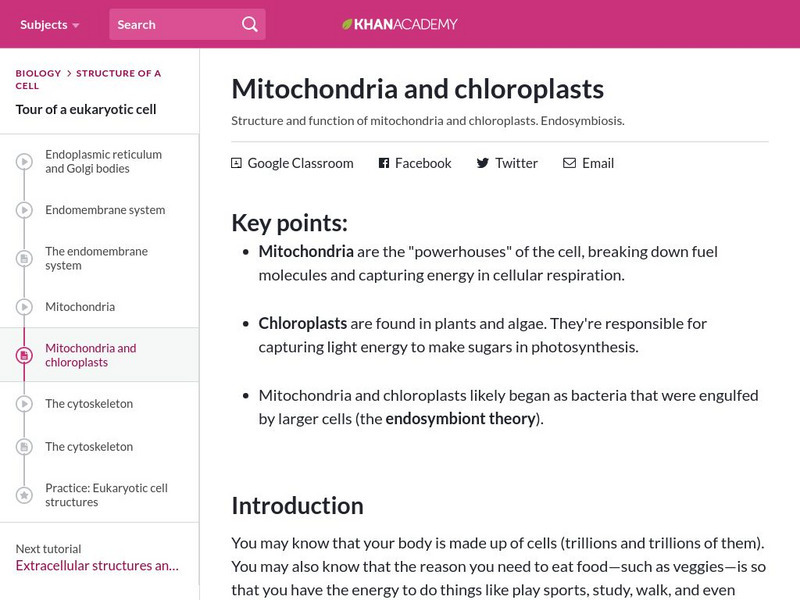Other
Dr. Saul: Biology in Motion
This interactive site provides animations and activities in several areas of physiology. The images are simple, but clear. The accompanying text provides a good description of the process being shown.
Khan Academy
Khan Academy: Mitochondria and Chloroplasts
Resource takes a look at the structure and function of the organelles mitochondria and chloroplasts. It also examines endosymbiosis, where the organelles probably came from.
Khan Academy
Khan Academy: The Cytoskeleton
There are three types of protein fibers in the cytoskeleton: microfilaments, intermediate filaments, and microtubules. This resource examines each type of filament, as well as some specialized structures: flagella, cilia, and centrosomes.
BiologyWise
Biology Wise: Endothelial Cells and Epithelial Cells
Discusses the differences between endothelial and epithelial cells, including where they are found in the human body, their function, and their structure.
CK-12 Foundation
Ck 12: Biology: Structure of Bones
[Free Registration/Login may be required to access all resource tools.] Describes the cells and tissues that make up bones.
Khan Academy
Khan Academy: Prokaryote Structure
This tutorial gives an overview of prokaryotes (bacteria and archaea) along with an explanation of structural features of prokaryotic cells.
CK-12 Foundation
Ck 12: Life Science: Prokaryotic and Eukaryotic Cells
[Free Registration/Login may be required to access all resource tools.] There are two basic types of cells, prokaryotic cells and eukaryotic cells. The main difference between eukaryotic and prokaryotic cells is that eukaryotic cells...
CK-12 Foundation
Ck 12: Life Science: Human Egg Cells
[Free Registration/Login may be required to access all resource tools.] When a baby girl is born, her ovaries contain all of the eggs they will ever produce. But these eggs are not fully developed. They develop only after she starts...
BiologyWise
Biology Wise: Tips on How to Make a Plant Cell Model
Describes the steps for making a model of a plant cell in two different ways. The first way uses mostly sweet foods and the second way uses a shoebox, clay, and simple materials.
Ducksters
Ducksters: Biology for Kids: Cell Mitochondria
Study the mitochondria in the science of biology on this site. Find out how these tiny organelles inside cells produce energy for the rest of the cell through respiration.
BiologyWise
Biology Wise: Vacuole Structure
The structure and function of a vacuole inside a plant cell are described.
Ducksters
Ducksters: Biology for Kids: Plant Cell Chloroplasts
Study the plant cell chloroplasts in the science of biology including their function, structure, and how they help make energy through the process of photosynthesis on this site.
BiologyWise
Biology Wise: Plant Cell Organelles
Explains how plant and animal cells are different and describes the organelles in a plant cell.
CK-12 Foundation
Ck 12: Life Science: Cell Nucleus
[Free Registration/Login may be required to access all resource tools.] The nucleus is only found in eukaryotic cells. It contains most of the genetic material of the cell. It is surrounded by a double membrane, or nuclear envelope, that...
BiologyWise
Biology Wise: The Cell Wall Functions in Plants and Animal
Describes the composition and functions of cell walls in plants, algae, fungi, and bacteria.
BiologyWise
Biology Wise: Guide on How to Make an Animal Cell Model
Describes the steps in how to make a model of an animal cell using simple materials.
Yale University
Yale University Center for Structural Biology
This site is an excellent resource on the research and graduate studies programs in the field of biophysics.
National Health Museum
Access Excellence: Graphics Gallery of Biotechnology
This site provides simple diagrams on all major topics in cell biology, genetics and biotechnology.
CK-12 Foundation
Ck 12: Biology: Characteristics of Life
[Free Registration/Login may be required to access all resource tools.] Describes the characteristics of life.
BiologyWise
Biology Wise: Lysosome Structure
Lysosomes are found in both plant and animal cells. The structure and functions of this cell organelle are described here, with note made of the diseases that can be caused by defective lysosomes.
BiologyWise
Biology Wise: A Brief Comparison of Plant Cell vs. Animal Cell
Presents labeled illustrations of a plant cell and an animal cell which demonstrate the parts that are common and different. This is followed by a discussion of their similarities and then of their differences.
BiologyWise
Biology Wise: Diagram of Plant Cell and Functions of Its Organelles
Provides a labeled diagram of a plant cell and descriptions of the characteristics and functions of many of its organelles.
BiologyWise
Biology Wise: A Labeled Diagram That Explains Function of Nucleolus
Explains what the cell nucleolus is, its functions, and its structure.
BiologyWise
Biology Wise: Rough Endoplasmic Reticulum
The endoplasmic reticulum is found in eukaryotic cells and has three layers. Proteins are synthesized in the rough endoplasmic reticulum and its structure and functions are described here.













